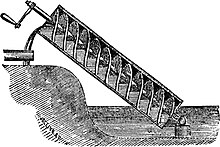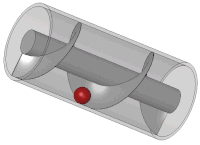Archimedes' screw



Archimedes' screw is a machine. It is a type of pump used for raising water up. It is a screw inside a fairly tight-fitting cylinder. With the bottom end in water, the screw lifts water up to the top, where it pours out of a spout. The screw can be turned by hand, or by a windmill, or by an engine. The screw is often used for filling irrigation ditches.
Archimedes wrote about it when he was in Alexandria, Egypt. It is not known for certain whether he did invent it, but it is always attributed to him.[1][2] The Archimedes screw is still much in use all over the world.
There is also a kind of reverse Archimedes' screw. Water poured in on top turns the screw. The turning drives an electric generator, which makes electricity. It is good for rivers with modest water drops ('low heads'). The reverse screw has the same benefits as using the screw for pumping: it can handle very dirty water and widely varying rates of flow, with high efficiency.
References[change | change source]
- P. J. Kantert: „Manual for Archimedean Screw Pump“, Hirthammer Verlag 2008, ISBN 978-3-88721-896-6.
- P. J. Kantert: „Praxishandbuch Schneckenpumpe“, Hirthammer Verlag 2008, ISBN 978-3-88721-202-5.
- ↑ Oleson, John Peter 1984. Greek and Roman mechanical water-lifting devices: the history of a technology. Dordrecht: D. Reidel. ISBN 90-277-1693-5
- ↑ Dalley S. & Oleson J.P. 2003. Sennacherib, Archimedes, and the water screw: the context of invention in the ancient world. Technology and Culture 44 (1) 1-26. [1][permanent dead link]
